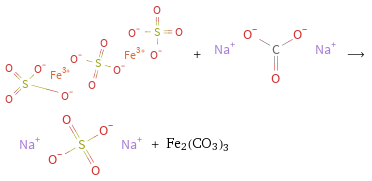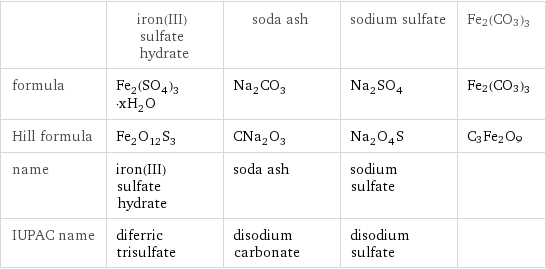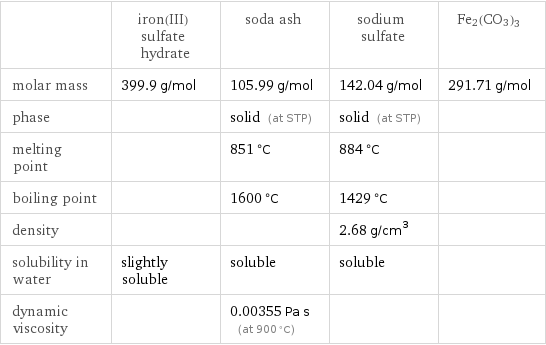Input interpretation

Fe_2(SO_4)_3·xH_2O iron(III) sulfate hydrate + Na_2CO_3 soda ash ⟶ Na_2SO_4 sodium sulfate + Fe2(CO3)3
Balanced equation

Balance the chemical equation algebraically: Fe_2(SO_4)_3·xH_2O + Na_2CO_3 ⟶ Na_2SO_4 + Fe2(CO3)3 Add stoichiometric coefficients, c_i, to the reactants and products: c_1 Fe_2(SO_4)_3·xH_2O + c_2 Na_2CO_3 ⟶ c_3 Na_2SO_4 + c_4 Fe2(CO3)3 Set the number of atoms in the reactants equal to the number of atoms in the products for Fe, O, S, C and Na: Fe: | 2 c_1 = 2 c_4 O: | 12 c_1 + 3 c_2 = 4 c_3 + 9 c_4 S: | 3 c_1 = c_3 C: | c_2 = 3 c_4 Na: | 2 c_2 = 2 c_3 Since the coefficients are relative quantities and underdetermined, choose a coefficient to set arbitrarily. To keep the coefficients small, the arbitrary value is ordinarily one. For instance, set c_1 = 1 and solve the system of equations for the remaining coefficients: c_1 = 1 c_2 = 3 c_3 = 3 c_4 = 1 Substitute the coefficients into the chemical reaction to obtain the balanced equation: Answer: | | Fe_2(SO_4)_3·xH_2O + 3 Na_2CO_3 ⟶ 3 Na_2SO_4 + Fe2(CO3)3
Structures

+ ⟶ + Fe2(CO3)3
Names

iron(III) sulfate hydrate + soda ash ⟶ sodium sulfate + Fe2(CO3)3
Equilibrium constant
![Construct the equilibrium constant, K, expression for: Fe_2(SO_4)_3·xH_2O + Na_2CO_3 ⟶ Na_2SO_4 + Fe2(CO3)3 Plan: • Balance the chemical equation. • Determine the stoichiometric numbers. • Assemble the activity expression for each chemical species. • Use the activity expressions to build the equilibrium constant expression. Write the balanced chemical equation: Fe_2(SO_4)_3·xH_2O + 3 Na_2CO_3 ⟶ 3 Na_2SO_4 + Fe2(CO3)3 Assign stoichiometric numbers, ν_i, using the stoichiometric coefficients, c_i, from the balanced chemical equation in the following manner: ν_i = -c_i for reactants and ν_i = c_i for products: chemical species | c_i | ν_i Fe_2(SO_4)_3·xH_2O | 1 | -1 Na_2CO_3 | 3 | -3 Na_2SO_4 | 3 | 3 Fe2(CO3)3 | 1 | 1 Assemble the activity expressions accounting for the state of matter and ν_i: chemical species | c_i | ν_i | activity expression Fe_2(SO_4)_3·xH_2O | 1 | -1 | ([Fe2(SO4)3·xH2O])^(-1) Na_2CO_3 | 3 | -3 | ([Na2CO3])^(-3) Na_2SO_4 | 3 | 3 | ([Na2SO4])^3 Fe2(CO3)3 | 1 | 1 | [Fe2(CO3)3] The equilibrium constant symbol in the concentration basis is: K_c Mulitply the activity expressions to arrive at the K_c expression: Answer: | | K_c = ([Fe2(SO4)3·xH2O])^(-1) ([Na2CO3])^(-3) ([Na2SO4])^3 [Fe2(CO3)3] = (([Na2SO4])^3 [Fe2(CO3)3])/([Fe2(SO4)3·xH2O] ([Na2CO3])^3)](../image_source/89f3db676f666ad4196b4874ed0ea69d.png)
Construct the equilibrium constant, K, expression for: Fe_2(SO_4)_3·xH_2O + Na_2CO_3 ⟶ Na_2SO_4 + Fe2(CO3)3 Plan: • Balance the chemical equation. • Determine the stoichiometric numbers. • Assemble the activity expression for each chemical species. • Use the activity expressions to build the equilibrium constant expression. Write the balanced chemical equation: Fe_2(SO_4)_3·xH_2O + 3 Na_2CO_3 ⟶ 3 Na_2SO_4 + Fe2(CO3)3 Assign stoichiometric numbers, ν_i, using the stoichiometric coefficients, c_i, from the balanced chemical equation in the following manner: ν_i = -c_i for reactants and ν_i = c_i for products: chemical species | c_i | ν_i Fe_2(SO_4)_3·xH_2O | 1 | -1 Na_2CO_3 | 3 | -3 Na_2SO_4 | 3 | 3 Fe2(CO3)3 | 1 | 1 Assemble the activity expressions accounting for the state of matter and ν_i: chemical species | c_i | ν_i | activity expression Fe_2(SO_4)_3·xH_2O | 1 | -1 | ([Fe2(SO4)3·xH2O])^(-1) Na_2CO_3 | 3 | -3 | ([Na2CO3])^(-3) Na_2SO_4 | 3 | 3 | ([Na2SO4])^3 Fe2(CO3)3 | 1 | 1 | [Fe2(CO3)3] The equilibrium constant symbol in the concentration basis is: K_c Mulitply the activity expressions to arrive at the K_c expression: Answer: | | K_c = ([Fe2(SO4)3·xH2O])^(-1) ([Na2CO3])^(-3) ([Na2SO4])^3 [Fe2(CO3)3] = (([Na2SO4])^3 [Fe2(CO3)3])/([Fe2(SO4)3·xH2O] ([Na2CO3])^3)
Rate of reaction
![Construct the rate of reaction expression for: Fe_2(SO_4)_3·xH_2O + Na_2CO_3 ⟶ Na_2SO_4 + Fe2(CO3)3 Plan: • Balance the chemical equation. • Determine the stoichiometric numbers. • Assemble the rate term for each chemical species. • Write the rate of reaction expression. Write the balanced chemical equation: Fe_2(SO_4)_3·xH_2O + 3 Na_2CO_3 ⟶ 3 Na_2SO_4 + Fe2(CO3)3 Assign stoichiometric numbers, ν_i, using the stoichiometric coefficients, c_i, from the balanced chemical equation in the following manner: ν_i = -c_i for reactants and ν_i = c_i for products: chemical species | c_i | ν_i Fe_2(SO_4)_3·xH_2O | 1 | -1 Na_2CO_3 | 3 | -3 Na_2SO_4 | 3 | 3 Fe2(CO3)3 | 1 | 1 The rate term for each chemical species, B_i, is 1/ν_i(Δ[B_i])/(Δt) where [B_i] is the amount concentration and t is time: chemical species | c_i | ν_i | rate term Fe_2(SO_4)_3·xH_2O | 1 | -1 | -(Δ[Fe2(SO4)3·xH2O])/(Δt) Na_2CO_3 | 3 | -3 | -1/3 (Δ[Na2CO3])/(Δt) Na_2SO_4 | 3 | 3 | 1/3 (Δ[Na2SO4])/(Δt) Fe2(CO3)3 | 1 | 1 | (Δ[Fe2(CO3)3])/(Δt) (for infinitesimal rate of change, replace Δ with d) Set the rate terms equal to each other to arrive at the rate expression: Answer: | | rate = -(Δ[Fe2(SO4)3·xH2O])/(Δt) = -1/3 (Δ[Na2CO3])/(Δt) = 1/3 (Δ[Na2SO4])/(Δt) = (Δ[Fe2(CO3)3])/(Δt) (assuming constant volume and no accumulation of intermediates or side products)](../image_source/a69eda04ca11a85247e84dd8e277206a.png)
Construct the rate of reaction expression for: Fe_2(SO_4)_3·xH_2O + Na_2CO_3 ⟶ Na_2SO_4 + Fe2(CO3)3 Plan: • Balance the chemical equation. • Determine the stoichiometric numbers. • Assemble the rate term for each chemical species. • Write the rate of reaction expression. Write the balanced chemical equation: Fe_2(SO_4)_3·xH_2O + 3 Na_2CO_3 ⟶ 3 Na_2SO_4 + Fe2(CO3)3 Assign stoichiometric numbers, ν_i, using the stoichiometric coefficients, c_i, from the balanced chemical equation in the following manner: ν_i = -c_i for reactants and ν_i = c_i for products: chemical species | c_i | ν_i Fe_2(SO_4)_3·xH_2O | 1 | -1 Na_2CO_3 | 3 | -3 Na_2SO_4 | 3 | 3 Fe2(CO3)3 | 1 | 1 The rate term for each chemical species, B_i, is 1/ν_i(Δ[B_i])/(Δt) where [B_i] is the amount concentration and t is time: chemical species | c_i | ν_i | rate term Fe_2(SO_4)_3·xH_2O | 1 | -1 | -(Δ[Fe2(SO4)3·xH2O])/(Δt) Na_2CO_3 | 3 | -3 | -1/3 (Δ[Na2CO3])/(Δt) Na_2SO_4 | 3 | 3 | 1/3 (Δ[Na2SO4])/(Δt) Fe2(CO3)3 | 1 | 1 | (Δ[Fe2(CO3)3])/(Δt) (for infinitesimal rate of change, replace Δ with d) Set the rate terms equal to each other to arrive at the rate expression: Answer: | | rate = -(Δ[Fe2(SO4)3·xH2O])/(Δt) = -1/3 (Δ[Na2CO3])/(Δt) = 1/3 (Δ[Na2SO4])/(Δt) = (Δ[Fe2(CO3)3])/(Δt) (assuming constant volume and no accumulation of intermediates or side products)
Chemical names and formulas

| iron(III) sulfate hydrate | soda ash | sodium sulfate | Fe2(CO3)3 formula | Fe_2(SO_4)_3·xH_2O | Na_2CO_3 | Na_2SO_4 | Fe2(CO3)3 Hill formula | Fe_2O_12S_3 | CNa_2O_3 | Na_2O_4S | C3Fe2O9 name | iron(III) sulfate hydrate | soda ash | sodium sulfate | IUPAC name | diferric trisulfate | disodium carbonate | disodium sulfate |
Substance properties

| iron(III) sulfate hydrate | soda ash | sodium sulfate | Fe2(CO3)3 molar mass | 399.9 g/mol | 105.99 g/mol | 142.04 g/mol | 291.71 g/mol phase | | solid (at STP) | solid (at STP) | melting point | | 851 °C | 884 °C | boiling point | | 1600 °C | 1429 °C | density | | | 2.68 g/cm^3 | solubility in water | slightly soluble | soluble | soluble | dynamic viscosity | | 0.00355 Pa s (at 900 °C) | |
Units
